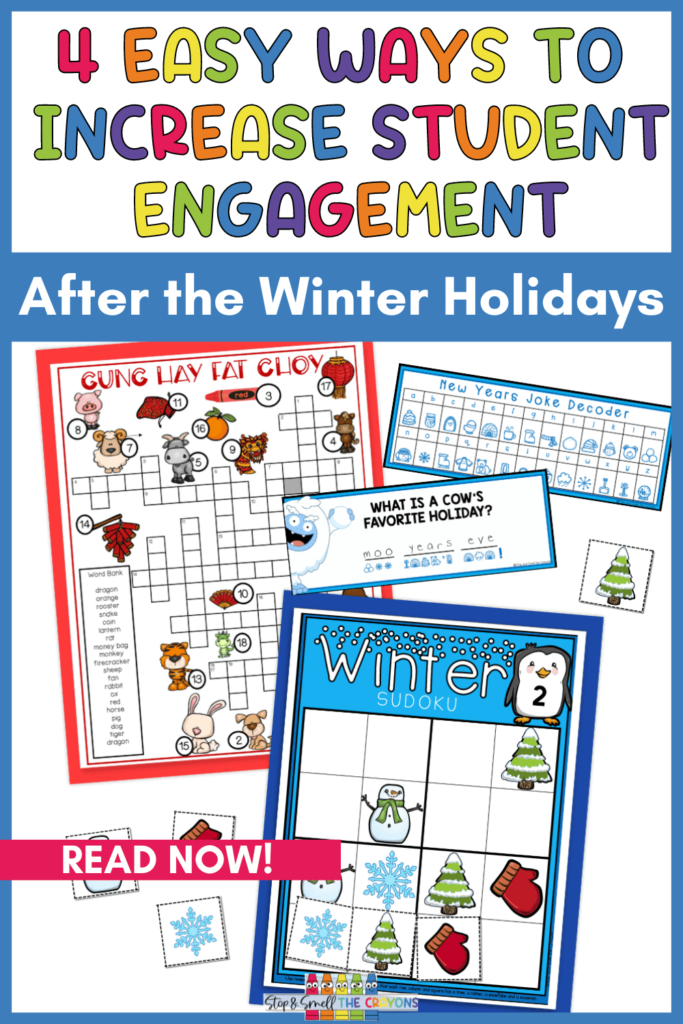I love the fresh start that January brings each year. After the whirlwind of the holiday season, settling back into a routine feels so refreshing. It’s the perfect time to set some new goals and start fresh! However, after a few weeks off, getting students engaged and excited about learning can be difficult. To help your students smoothly transition back into their routines after winter break, I’ve put together some activities that will get them excited and eager to learn again! Keep reading for some easy ways to increase student engagement after the winter holidays.
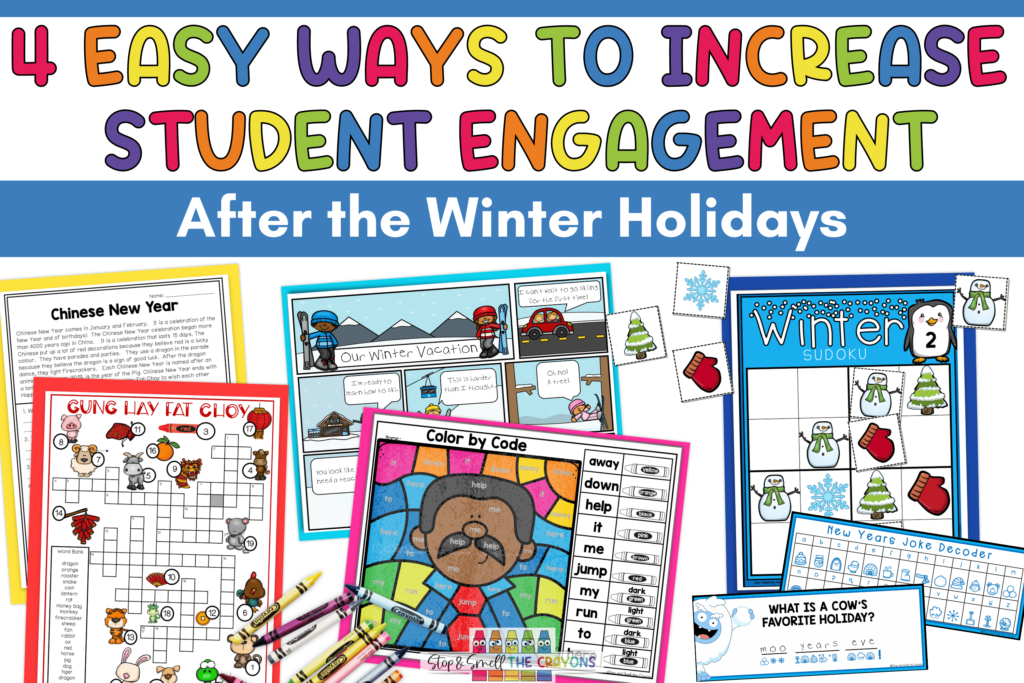
1. Increase Student Engagement with Routine
Having a consistent morning routine is even more important after a break. It provides a sense of stability and predictability, which helps our students feel secure and ready to learn. These January activities are designed to be engaging and educational, all while making the transition back to school as smooth as possible. Getting back into routine is the first step to getting students engaged and ready to learn.
Morning Work and ELA/Math Spiral Review
One of my favorite January activities is using my 1st Grade Morning Work Spiral Math and ELA pages. These activity sheets are a lifesaver for setting the tone for the day. As soon as my students finish unpacking, they dive right into these pages. They cover a range of topics from math to language arts, making them perfect for reinforcing skills.
My kiddos work on problems involving tens and ones, circle the correct day of the week, and even color-code winter clothes. These activities reinforce their math skills and also add a bit of fun to the mix. Seeing their confidence grow as they solve these problems is always rewarding!
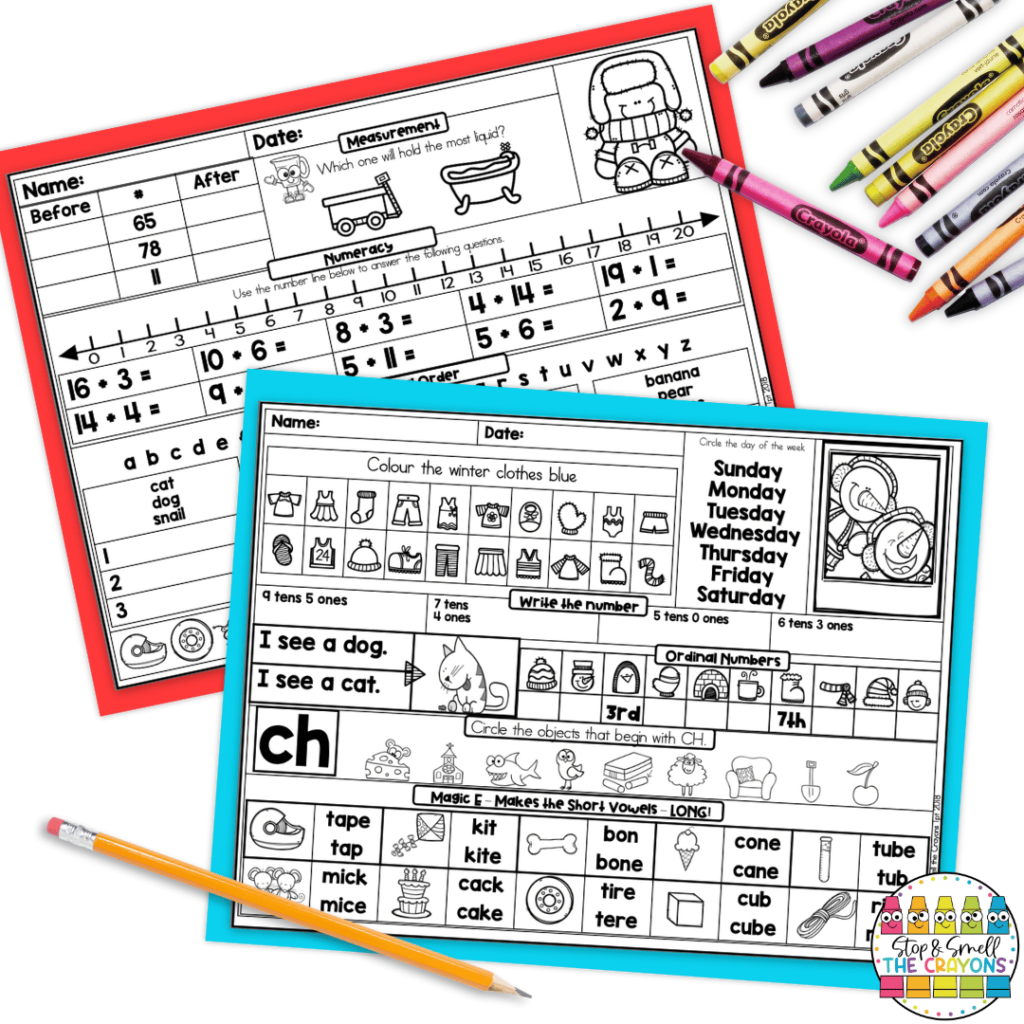
Then, my students identify words that begin with specific sounds, practice writing numbers, and solve puzzles that involve long and short vowel sounds. These tasks are fantastic for reinforcing phonics and early reading skills. These skills help them become more proficient readers.
One of the most enjoyable parts of our morning routine is the creative writing prompts. The kiddos enjoy writing words that rhyme with given words and complete sentences using the correct words. This boosts their vocabulary and encourages them to think creatively to express their thoughts in writing.
Having a consistent morning routine is so important to laying the foundation for the day. If you’ve never used morning work to start your day, January is a great time to get started.
2. Increase Student Engagement with January Holidays
Who doesn’t love a reason to celebrate?!? Weaving in holidays is an easy way to increase student engagement. After the winter break, multiple January holidays will help you do just that. From celebrating New Year’s Day to learning about Chinese New Year, student engagement will be high with these January activities.
New Year Traditions and Celebrations
Engaging resources for January activities that center around holidays kickstart with my New Year’s Traditions and Celebrations mini-unit. This set includes a variety of activities that are perfect to engage my students by explaining more about New Year’s Day and the reasoning behind the celebration!
We start by learning about New Year’s traditions through informative sheets and activities. Students have the chance to fill in the blanks on information sheets about New Year’s traditions around the world. This teaches them about different cultures and enhances their reading comprehension skills.
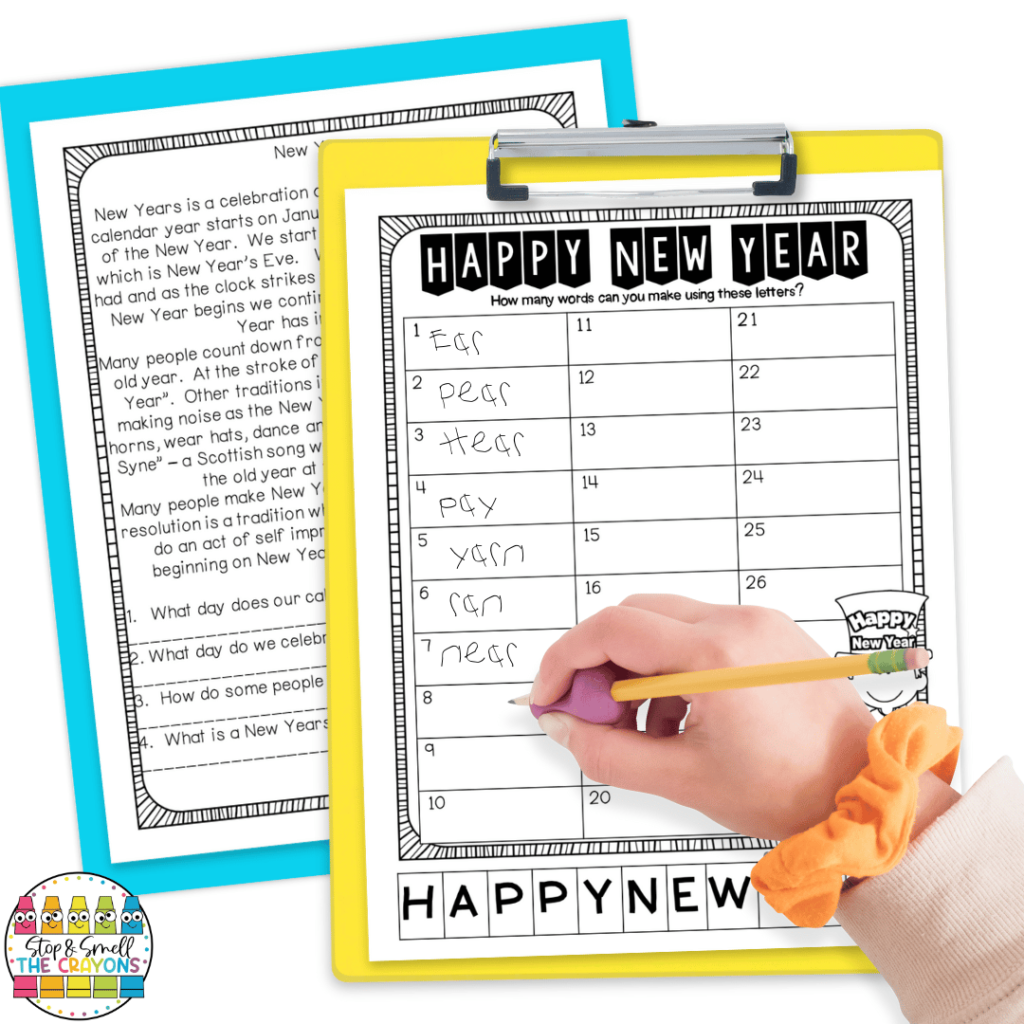
One of the highlights is the word search and making words activities. Students search for words related to New Year’s celebrations and create new words from given letters. This is a fantastic way to boost their vocabulary and spelling skills while keeping them engaged.
Another fun activity is writing New Year’s resolutions. Our students think about their personal goals for the new year and write about what they want to achieve or improve. This encourages self-reflection and goal-setting, helping them start the year with a positive mindset.
The 100’s chart hidden picture activity is always a hit. Students color a 100’s chart to reveal a hidden picture related to New Year’s. This combines math practice with a fun art activity, which makes learning memorable and keeps our students excited about their tasks.
Although we aren’t in school on New Year’s Day, the first days back are the perfect time to learn more about this holiday. And. . . it makes for an easy way to ease back into the routine of school after the long winter break.
New Year Math Activity – Grid Coordinates
The New Year Math Activity: Grid Coordinates is a fun way to engage our students through combining math practice with a bit of art. I start by making copies of the grid and mystery pictures for each of my students. I make sure to review how to use the grid coordinates to find the correct squares. This is a great way to review or introduce the concept of coordinates!
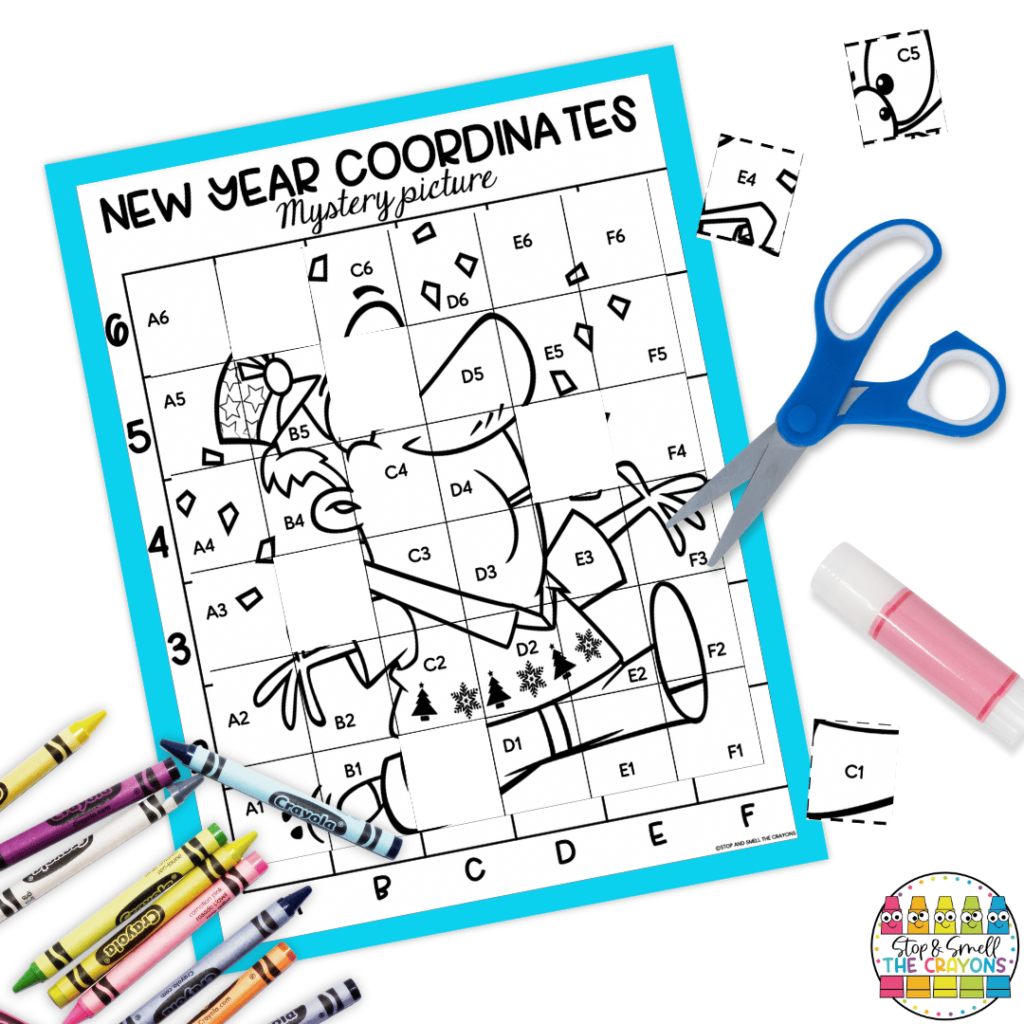
Students carefully cut out each square along the dotted lines. I encourage them to cut slowly and neatly to ensure their pieces remain square to help make the picture clearer. Then they place each square on the corresponding grid coordinates listed on that square. Once all the pieces are placed correctly, they glue them down and color the picture. This activity not only helps with their understanding of coordinates but also enhances their fine motor skills and attention to detail.
To make it more exciting, I sometimes blow the pages up to 11×17 inches to create larger art pieces. These make awesome wall art and can be used to decorate bulletin boards or hallways. They add a festive New Year’s touch to our classroom, which really helps student engagement!
Digital New Year Math Activity for Google Classroom
I also created a Google Slides version of the New Year Math Grid Activity. This activity becomes accessible and easy to use for our students who prefer digital versions or if you prefer to project the activity to complete as a class.
In this digital version, students work on a virtual grid to place coordinates and reveal a mystery picture. They follow similar steps as the paper version but use Google Slides to manipulate the pieces. This reinforces their math skills and improves their ability to work with online tools. It’s a flexible option that can be used in the classroom or assigned as homework, ensuring that learning continues seamlessly regardless of the setting.
Exploring Chinese New Year Traditions
The Chinese New Year Activities resource is packed with engaging tasks that my students love. Here are some of the activities that make this resource a hit in my classroom!
We learn about Chinese New Year through a fun reading passage. This passage explains the significance of the holiday and how it’s celebrated. It also explains the many traditions of the holiday. From decorating with the color red, which is considered lucky, to the importance of the dragon parade, your students will love learning about this tradition filled holiday. Students also learn that each year is named after an animal.
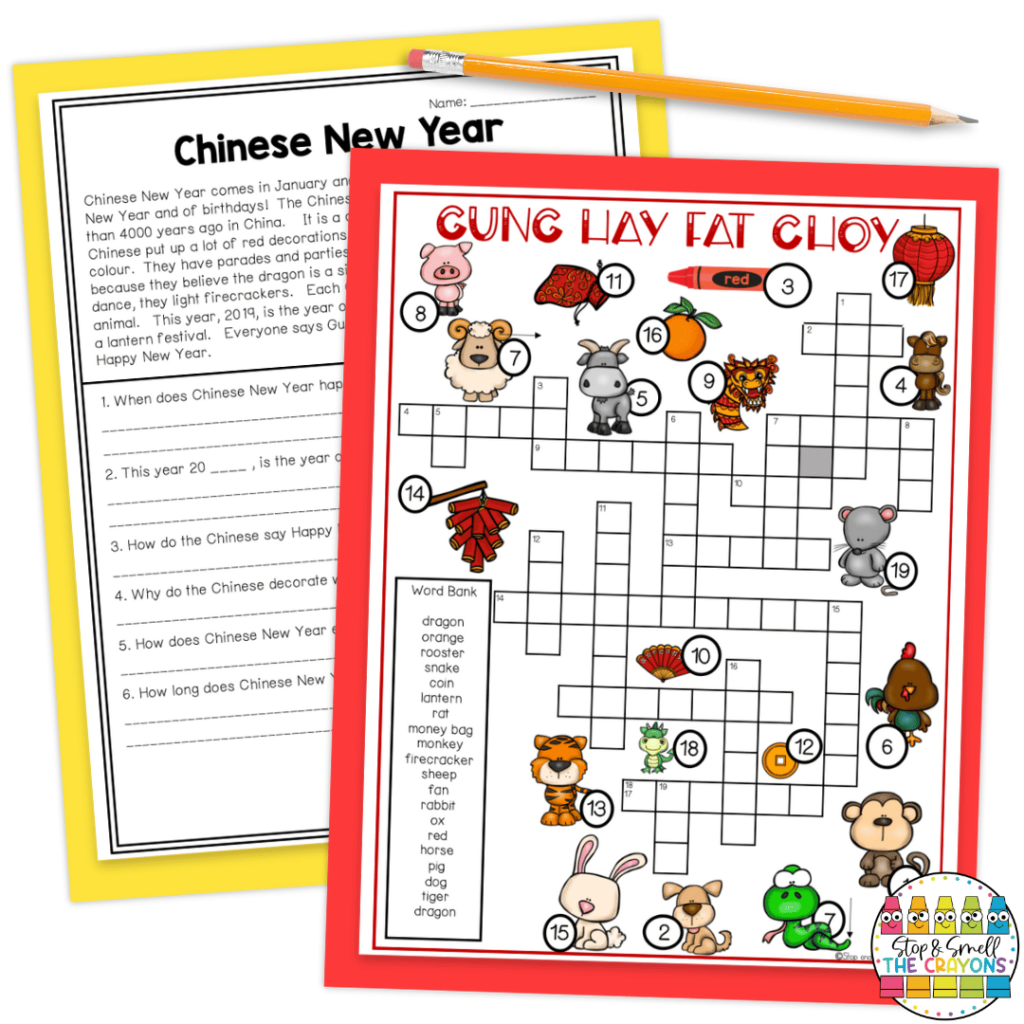
To reinforce their reading comprehension, students answer questions related to the passage. These questions prompt them to recall details such as the timing of the celebration, the animal of the current year, and traditional greetings like “Gung Hay Fat Choy.”
Another engaging task is the Chinese New Year Graphing activity. Students count and tally different items related to the holiday, such as lanterns and dragons, and then create a graph based on their findings. This integrates math skills with cultural learning, making it a well-rounded activity.
For a bit of creative fun, students can participate in a Chinese Zodiac I SPY game. They search for and count pictures of zodiac animals hidden in a larger image. This game is always a hit and helps them learn about the different animals in the Chinese zodiac in an interactive way.
3. Increase Student Engagement with Winter Themes
Kids everywhere love winter, and we can use that love to increase student engagement in the classroom. By weaving in winter themes like snow and arctic animals, we can make learning exciting and effortless. Here are a few of my favorite winter-themed activities that students have loved year after year.
Writing Winter Stories With Roll-A-Story
Another go-to resource for student engagement in January is my Creative Writing Prompts Roll-A-Story resource. Through this resource, students are inspired to write seasonal and holiday stories. This resource is amazing for sparking creativity and helping students develop their writing skills in an interactive way.
In my classroom, I explain how they will create stories based on the roll of a dice. This interactive element adds suspense and excitement to the writing process. Each student receives a set of prompts that include various seasonal and holiday themes.
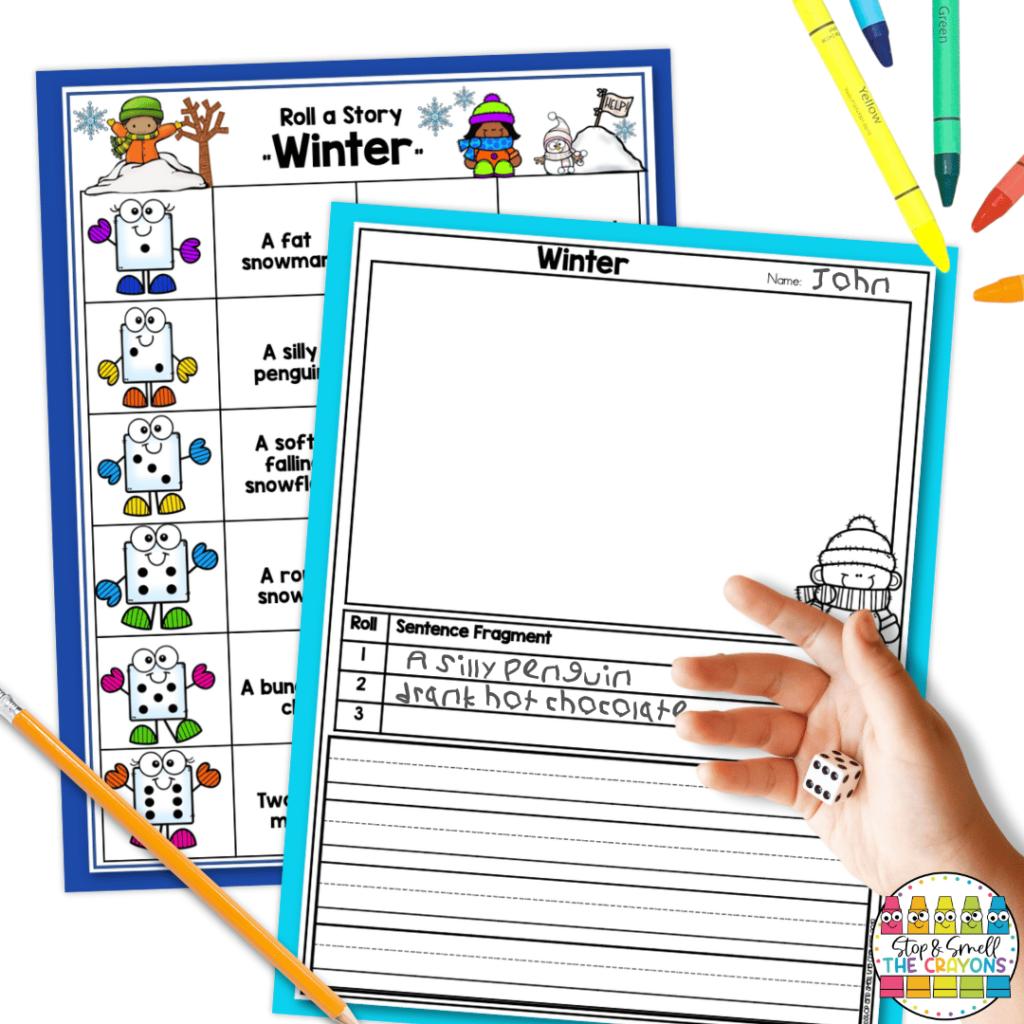
The activity starts with students rolling a dice three times. Each roll corresponds to a column on the prompt chart, which includes characters, actions, and settings. For example, if a student rolls a 2, 5, and 4, their story prompt might be about “A blue bird that sat in the grass under a bench.” This random combination often leads to funny and imaginative stories, keeping students engaged and entertained.
After finding their prompts, they begin writing their stories. I encourage them to expand their sentences by adding details and using their imagination. For example, a sentence like “A blue bird sat in the grass under a bench” might evolve into “A little blue bird sat quietly in the grass under a bench because it was raining.” This exercise improves their writing skills and helps them learn how to elaborate on their ideas.
Once the students have written their stories, they draw a picture to bring their stories to life. This step is always a favorite as it allows them to visualize their stories and add a personal touch to their work. The illustrations also help reinforce the connection between their written words and the images they create. It makes my teacher heart happy when I see them excited to write!
Winter Comic Strips Writing Fun
Keeping our students engaged with creative writing activities during the winter months can be a challenge. I’ve created a fantastic resource that has our students becoming comic strip authors through the Winter Writing Comic Strips resource. This resource helps our students practice their writing skills. It also allows them to explore their creativity through drawing and storytelling.
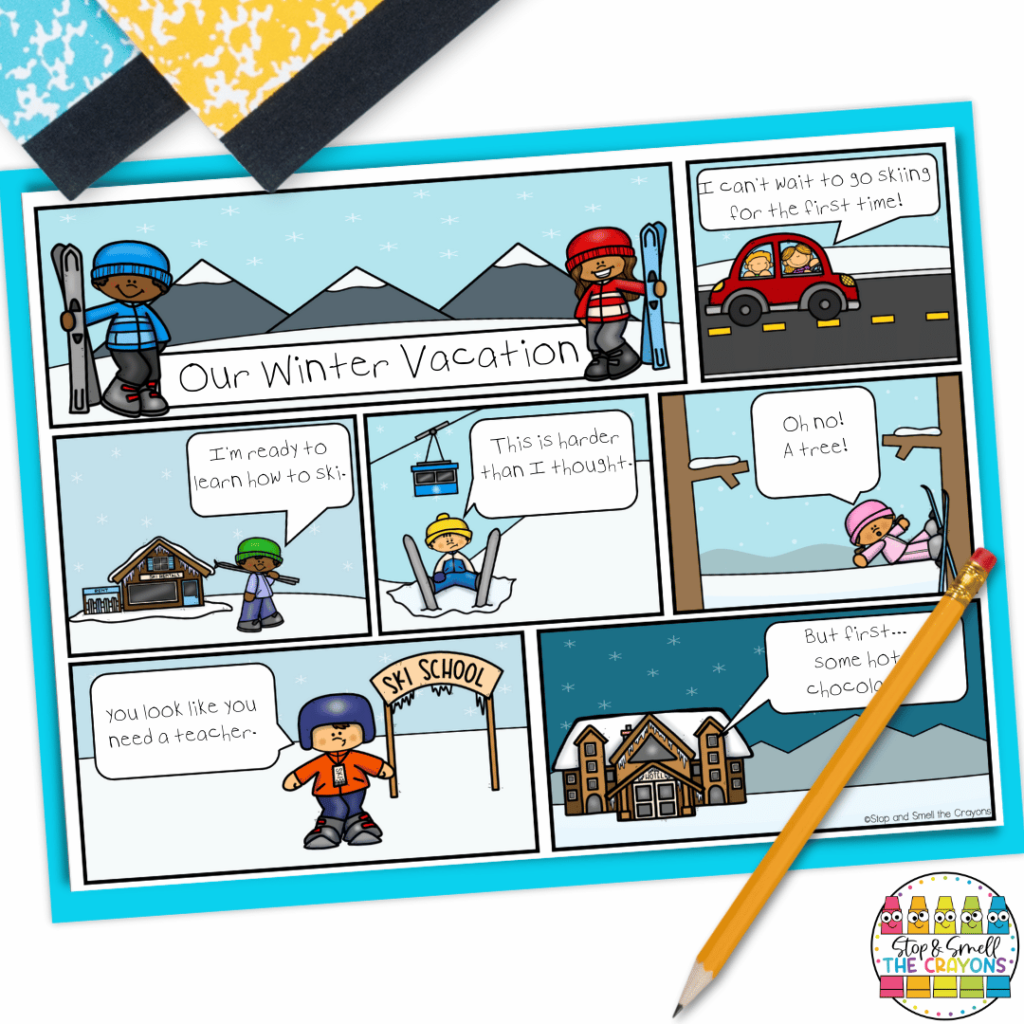
I start by introducing the concept of comic strips, explaining how they use a series of images and captions to tell a story. My students are always excited to create their own comics, as it’s a break from traditional writing assignments. Each student receives a comic strip template, which includes several blank panels for drawing and writing.
I guide my students through brainstorming their story ideas. We discuss winter-themed topics, such as a snowball fight, building a snowman, or a day on the ice rink. This brainstorming session helps them organize their thoughts and plan their comic strip.
Then, they begin drafting their comics. They start by sketching the images in each panel, ensuring that their drawings align with the storyline they’ve created. After the sketches are done, they add captions or speech bubbles to explain what’s happening in each scene. As they work, I move around the classroom, offering feedback and encouragement. I love seeing their unique stories come to life and how each student’s personality shines through their comic strip.
Once the comic strips are complete, we have a sharing session where each student presents their work to the class. This builds their confidence and allows them to practice public speaking skills. My students are always eager to share their stories and see and hear their classmates’ creations.
Penguin Centers for Math and Literacy Review
It always amazes me how obsessed some of my students become with penguins! I don’t blame them at all because they are very cute and interesting. To grab their attention, I created Penguin Themed Math and Literacy Centers to use in my classroom. These activities are favorites year after year. This resource is filled with a variety of math and literacy centers that will get your students reviewing key number sense and phonics skills. Starting January with a review is the best way I have found to help students get back into the school mindset after the break.
Here are a few of my favorite activities from this resource.
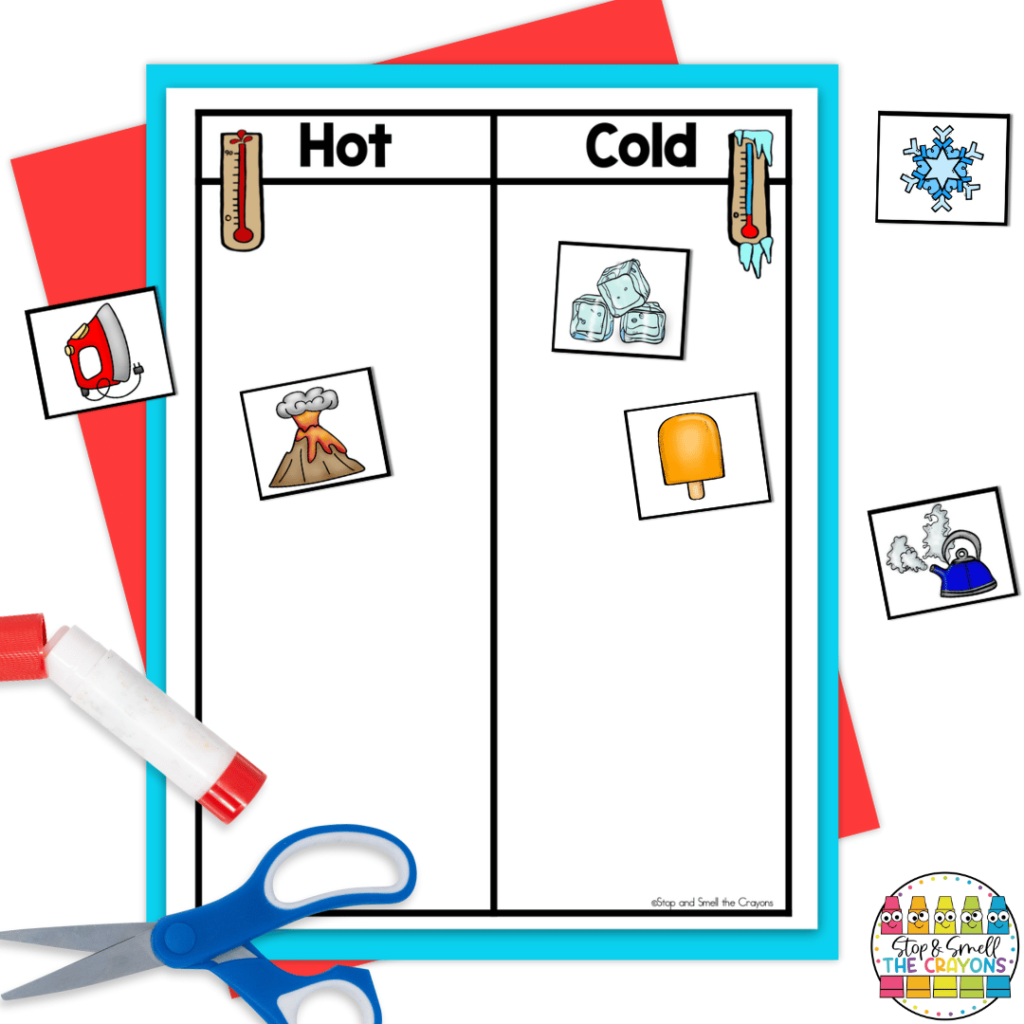
- Penguin Memory Game – Played like a traditional game, this center activity will have students matching different types of penguins. It’s great for learning to pay attention to detail, improving memory and concentration.
- Penguin Counting – From counting sets to filling in ten frames, this resource includes multiple math centers that will get your students working with numbers.
- Penguin Measurement – Two different measurement centers will get your students working with the concepts of length and ordering objects based on their size. Kids love these hands-on activities and they don’t realize what practical skills they are developing.
- Hot vs. Cold Sorting Activity – This is a great activity that gets your kids thinking critically as they sort objects based on temperature. Not only do they improve their ability to categorize objects, but it is a great vocabulary building activity too.
- Roll and Trace is a student favorite activity that will help with handwriting and fine motor skills. Students will trace letters, numbers, and shapes in this interactive center game.
- Penguin Sight Word Building is a fun hands-on work building game. Students will build sight words using the penguin letter cards. It’s a great way to work on reading and spelling these important words.
- Penguin Writing – We can’t forget about some writing center activities that connect the penguin theme. Students love using the penguin writing paper to create a story, write a list, or write simple sentences.
These activities, and many more, will save you so much time planning and prepping your January centers. Use them all month long!
Winter Sudoku Puzzles
Winter Sudoku Puzzles are one of the more brain-stretching January activities are are sure to increase student engagement! These logic puzzles are a fantastic way to engage our students and get their minds working.
I begin by introducing the concept of Sudoku, explaining how each row, column, and 2×2 square must contain one of each winter symbol: a tree, a mitten, a snowflake, and a snowman. This introduction sets the stage for understanding the rules and logic behind the puzzles, especially for my learners who may have never done Sudoku before.
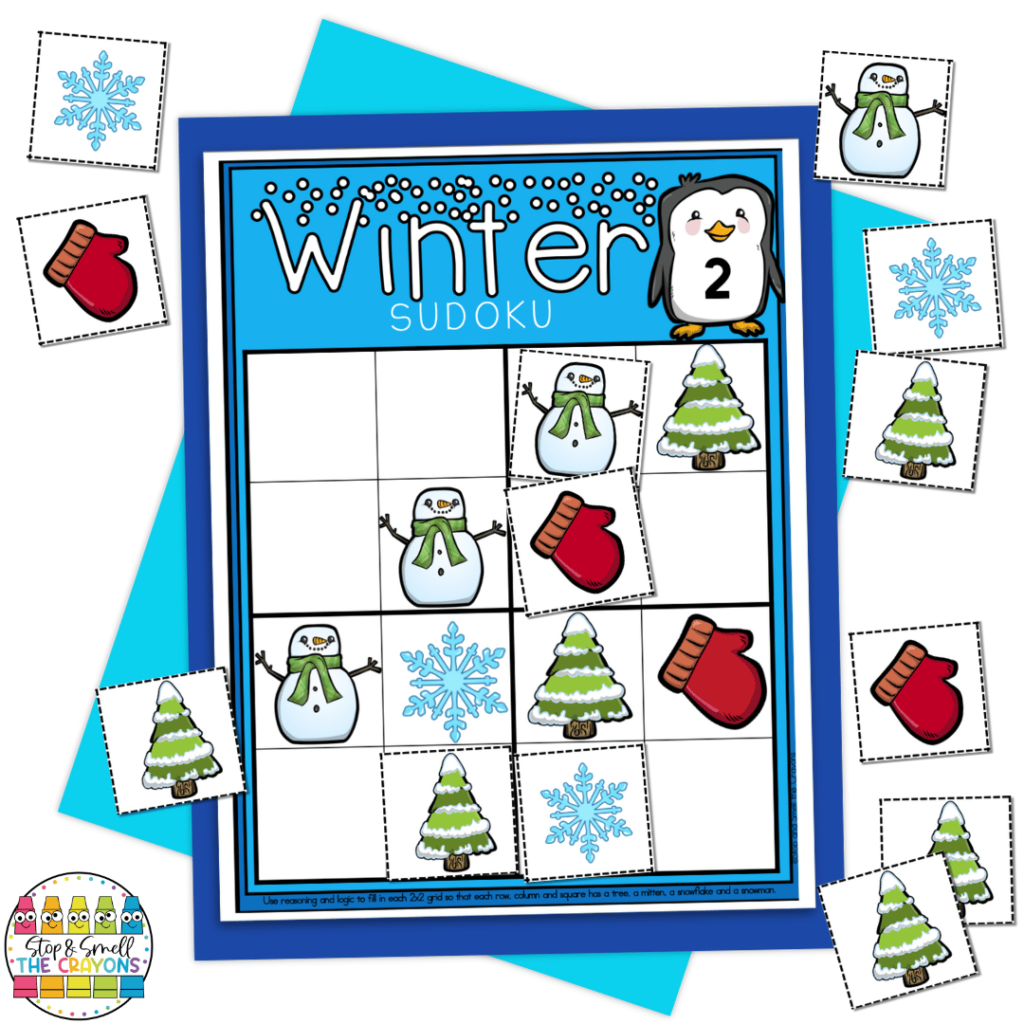
To make it interactive and collaborative, I project a color Sudoku puzzle on the whiteboard. I use laminated and cut-out pieces, each with a magnet on the back, to play as a class. Students take turns placing the pieces on the board where they think they belong. This group activity helps students learn from each other as they explain their thought processes and strategies.
For independent practice, I provide black and white worksheet versions of the Sudoku puzzles. These worksheets are great for fast finishers or as a transition activity after recess. I place copies on their desks, so they have something productive to work on as they settle back into the classroom.
I place laminated versions with Velcro in our math centers to be reused. Students can manipulate the pieces and solve the puzzles hands-on, which is particularly helpful for our tactile learners. This setup also allows them to correct mistakes easily without the pressure of finality.
Once they get a hang of them, these Sudoku puzzles are a hit during inside recess. I print out multiple copies and let students work on them independently or in pairs. It’s a quiet and productive way to spend recess time, keeping their minds active even during breaks.
Winter Multiplication Fun with BOOM Cards
I am always looking for ways to bring technology into our classroom activities to make learning more dynamic. One of my favorite resources for this is my Winter Multiplication Boom Cards. These digital task cards are perfect for reinforcing multiplication skills in a fun, interactive way!
To introduce the Boom Cards, I sometimes project them on our Smartboard and work through a few examples as a class. This helps familiarize students with how BOOM cards work and the types of questions they’ll encounter. It’s also a great way to review multiplication concepts together before they dive into independent practice.
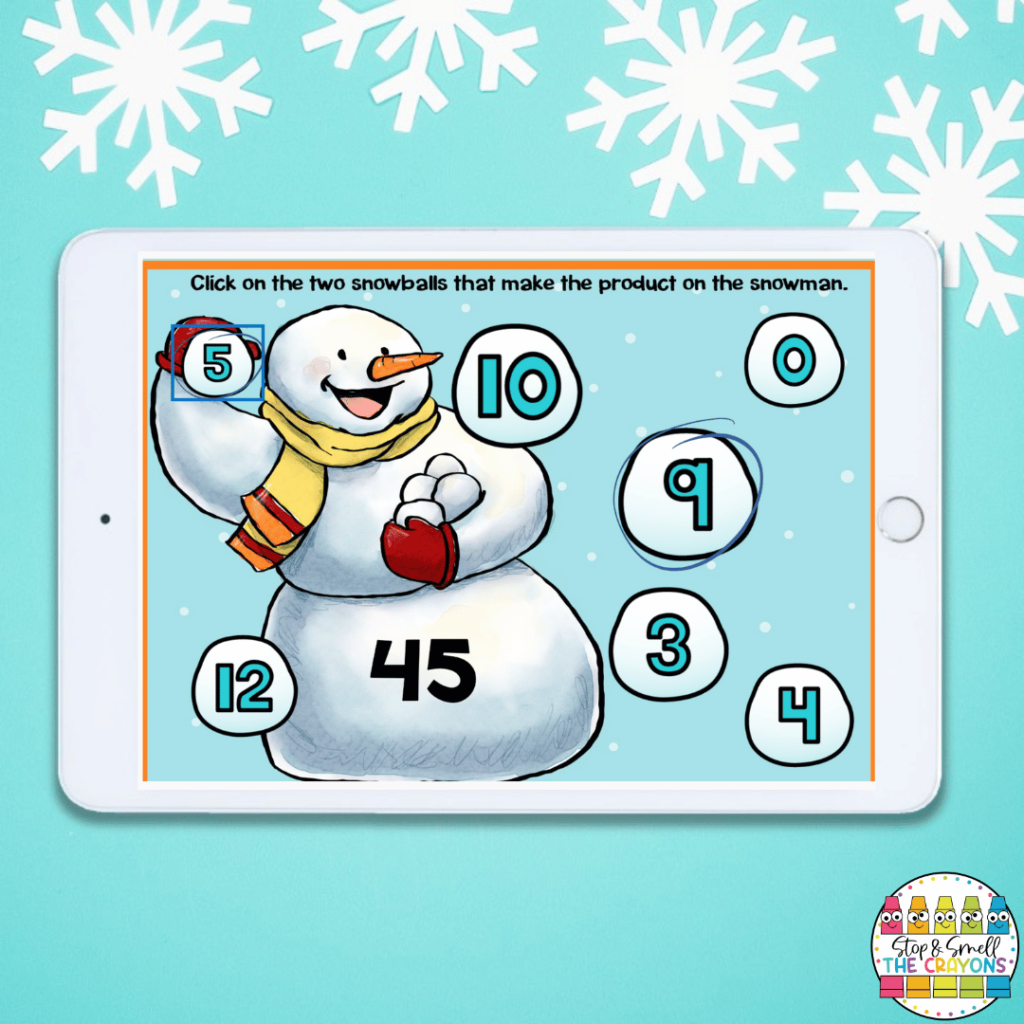
Once they are ready for independent practice, I make sure to share access through a digital platform like Google Classroom. The link will take my kiddos to the Boom Cards website on our classroom devices. These cards can be used on a Smartboard, computers, iPads, tablets, or any mobile device with internet access.
Each card has a multiplication problem, and students select the correct answer from multiple choices. One of the features I love the most about Boom Cards is their self-grading feature. As students work through the problems, their progress is tracked automatically, giving them instant feedback on their performance. This saves me time on grading while also helping my students learn from their mistakes in real-time.
I love using these Boom Cards for independent learning. Students can work at their own pace, which is great for differentiated instruction. Whether they’re in the classroom or at home, they can access their Boom Cards wherever they have a device and an internet connection. This flexibility is especially helpful for homework assignments or for students who need extra practice outside of school hours.
4. Increase Student Engagement with Fun & Games
One of the easiest ways to increase student engagement is to make it not seem like learning at all. Kids love to play, and they are quick to buy into anything that feels like play, even if it has an academic focus. Check out these activities that will make your classroom lessons feel like fun and games.
Coded Jokes
One of my favorite ways to do this is with my Coded Jokes resources. These resources provide a perfect mix of fun and learning in our literacy centers. These joke decoders have a sense of humor. They’re a great way to engage our kids and get them thinking critically. Here’s how I use this fantastic resource in our classroom!
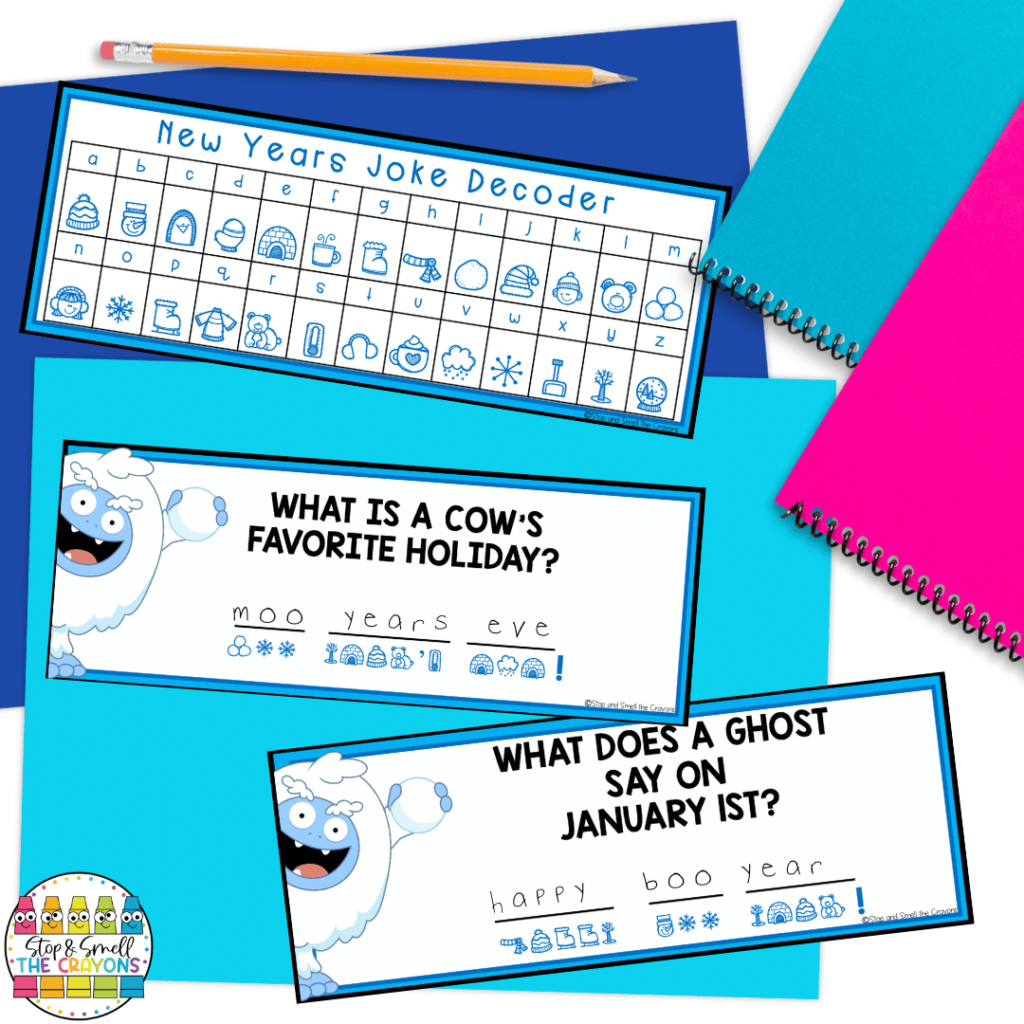
I start by introducing the concept of coded messages. Each letter of the alphabet is substituted with another letter. The students have to decode the jokes using the provided key. This activity is a great way to reinforce their understanding of the alphabet and improve their problem-solving skills.
One of the jokes we decode is, “What do mountains wear to keep warm?” The kids work through the code to reveal the answer: “Snow caps!” This always gets a good laugh and is a fantastic way to kickstart the day.
Another joke we decode is, “What did a gingerbread man put on his bed?” The answer, “A cookie sheet!” brings more giggles. My kiddos love seeing the punchlines come to life as they work through the codes.
This resource is perfect for independent work or small group activities. Students love the challenge of decoding the jokes. It’s a fantastic way to integrate some humor into our routine. It keeps them engaged and looking forward to what’s next.
Fun With Cootie Catchers
Adding some hands-on fun to our January activities can make a big difference in student engagement. One of my favorite ways to do this is with my collection of themed Cootie Catcher Jokes resources. These activities combine humor, interaction, and a bit of crafting, making them a hit in the classroom.
We begin by cutting out the cootie catcher along the red dotted lines and folding it according to the provided directions. The folding process itself is a great fine motor skill activity and a fun challenge for our students.
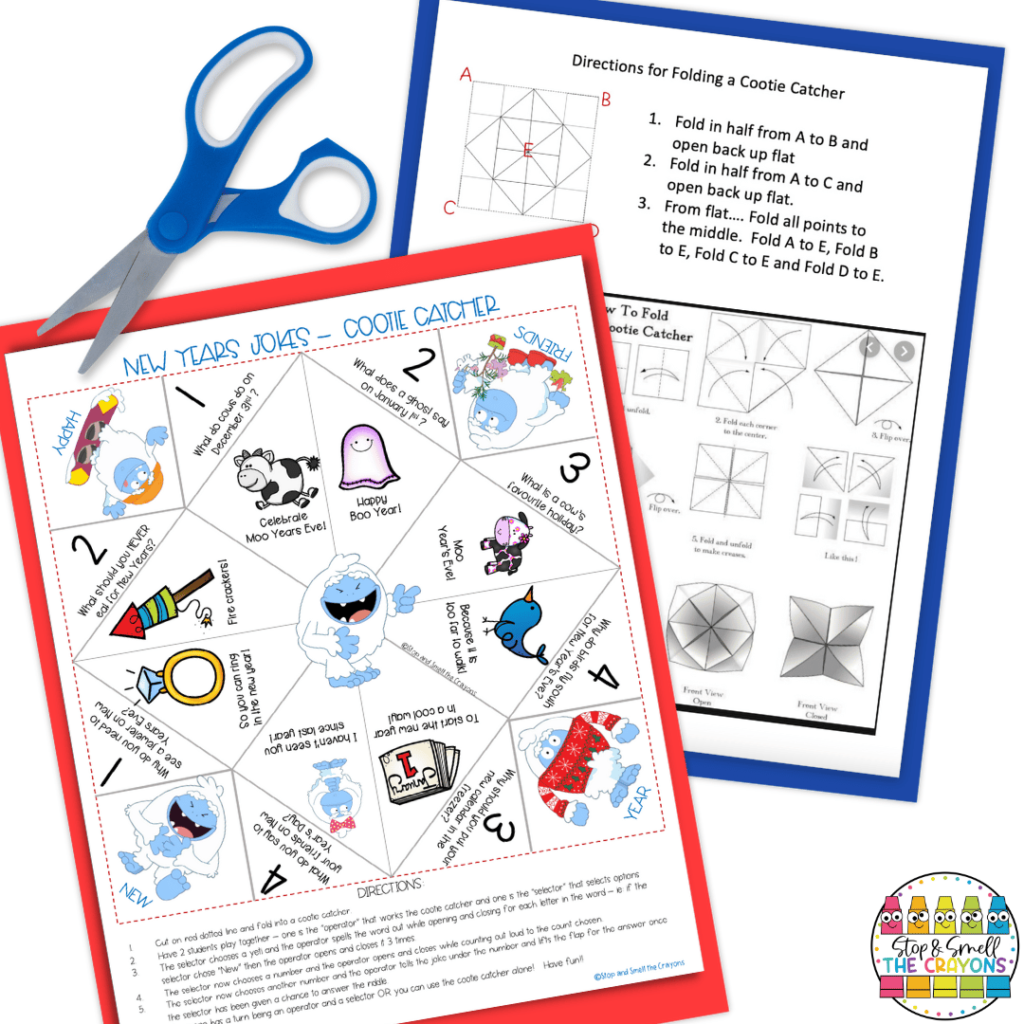
Once the cootie catchers are ready, I pair the students up. One will act as the “operator” and the other as the “selector.” The selector chooses a word from the outer flaps, and the operator spells it out, opening and closing the cootie catcher with each letter. For example, if the word “New” is chosen, the operator opens and closes it three times.
Next, the selector picks a number from inside, and the operator repeats the opening and closing process while counting out loud. Finally, the selector picks another number, and the operator reads the joke under the chosen number. For example, one of the jokes is, “What does a ghost say on January 1st?” The answer, revealed after a bit of suspense, is “Happy Boo Year!”
This activity provides a lot of laughs and encourages our students to practice their spelling and counting skills in a fun and engaging way.
These cootie catcher activities help our students improve their fine motor skills, practice spelling and counting, and follow multi-step instructions. The jokes provide a great way to introduce new vocabulary and concepts in a lighthearted manner.
Coloring Activities
One of the more effective January activities I incorporate into our classroom routine is the collection of Color By Code Sight Word practice pages. These activities are educational but help to make the kiddos feel like they are having fun while doing so instead of just working. The themed worksheets cover important events and celebrations throughout January, providing a variety of engaging learning experiences.
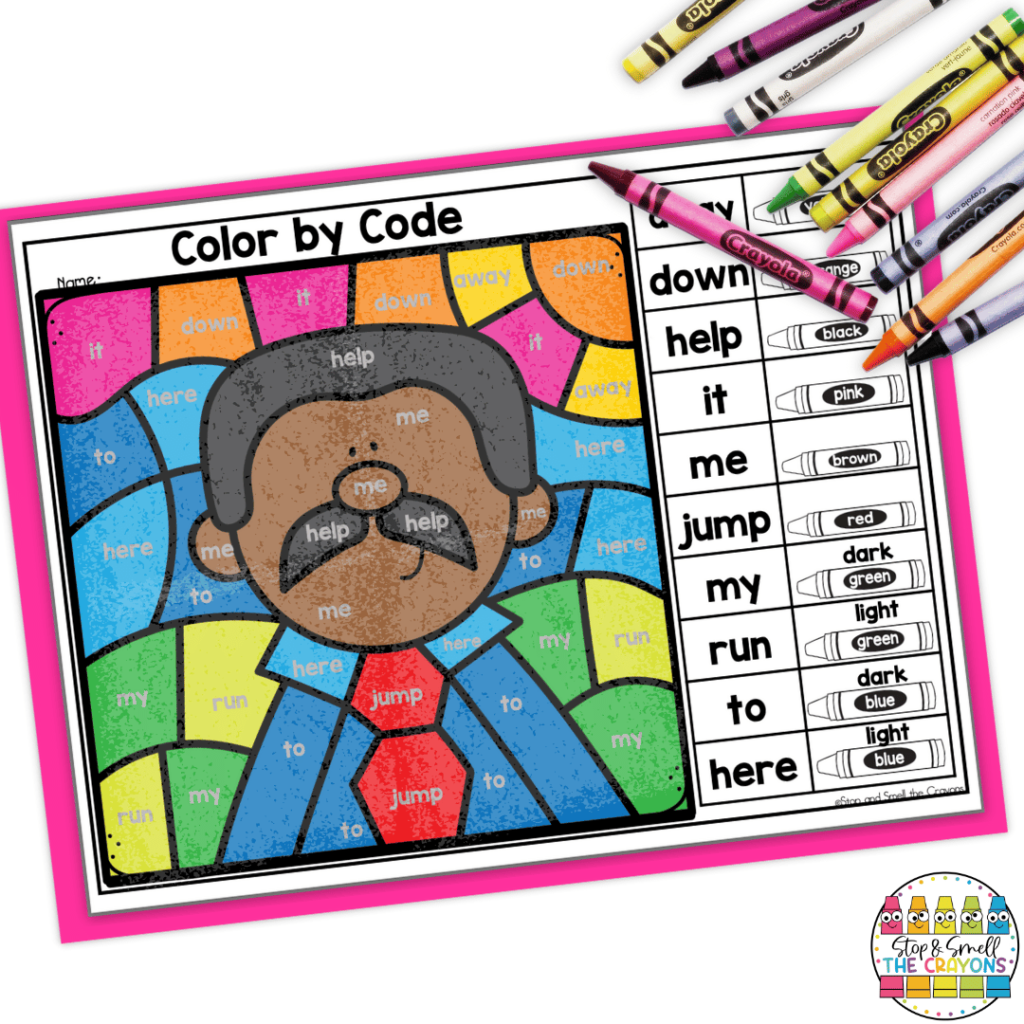
Themes range from specific holidays like New Year’s Day and Martin Luther King Jr. Day to more general themes like 100th Day of School and Winter. These worksheets are designed to help students practice their sight words while enjoying some festive coloring. As they color by code, they reveal fun images connected to the chosen theme, which keeps them excited and motivated. The combination of sight word recognition and coloring makes learning feel like a game.
These pages are simple to prepare and explain! I hand out the worksheets and explain the instructions. Each page has a list of sight words paired with specific colors. The students read the sight words and use the paired colors to fill in sections of the picture. As they work, I walk around the classroom to provide assistance and encouragement. This method helps them practice reading and reinforces their understanding of sight words in a fun and interactive way.
Winter Color By Code Multiplication Activity
Bringing some seasonal fun into math practice can make a huge difference in student engagement and motivation. One of my students’ favorite resources for this is the Multiplication Winter Color by Code. These activities do wonders for reinforcing multiplication skills while allowing students to express their creativity through coloring.
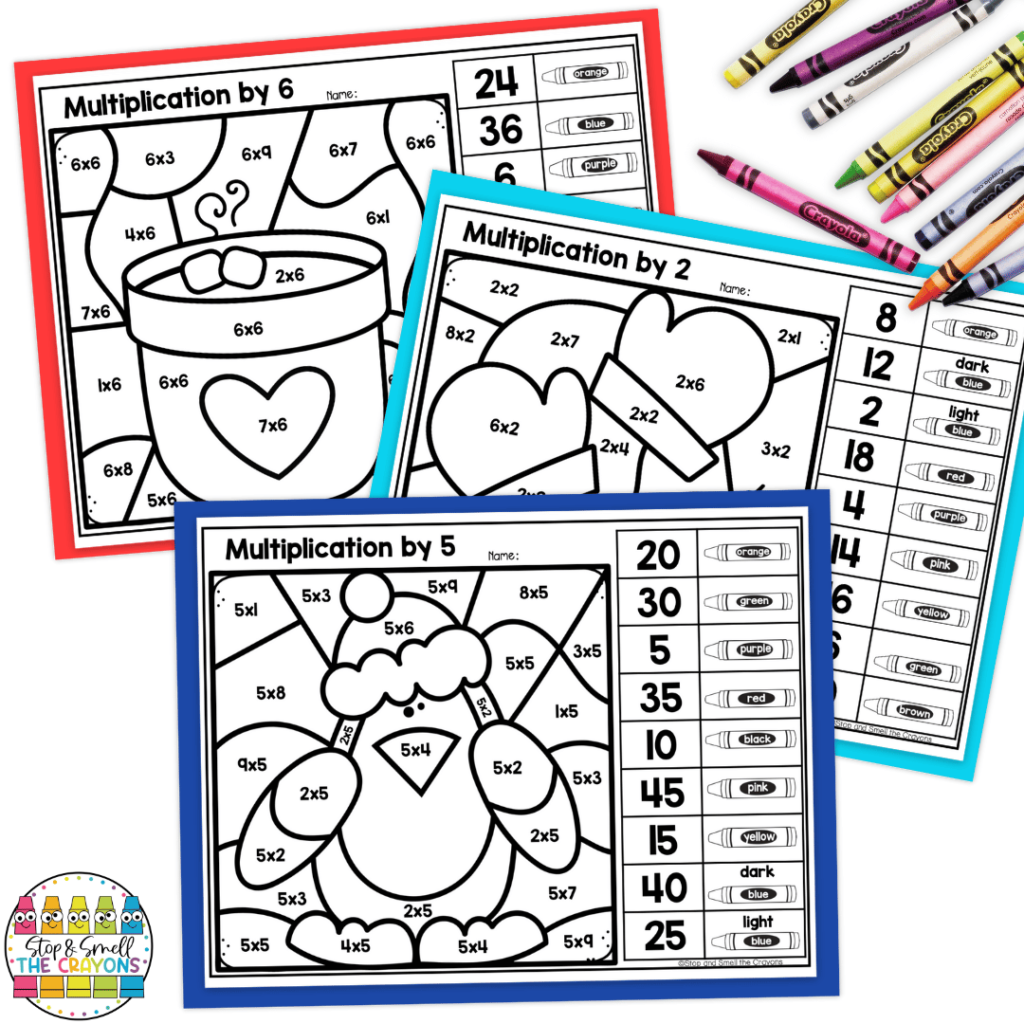
I begin by passing out the worksheets to each student. Each sheet features a winter-themed image divided into sections. Each section is labeled with a multiplication problem. Students solve the multiplication problems and then color the sections according to a code that corresponds to their answers. For example, if the product is 36, they might color that section blue.
The variety of multiplication problems covers different times tables, making it an excellent review of all the multiplication facts. The winter theme adds a fun and festive element, which helps maintain our students’ interest. Whether they’re working on problems involving the 2s, 3s, or 9s tables, our students are continuously challenged and engaged.
Once the coloring is complete, the students love seeing their winter scenes come to life. It’s a rewarding experience for them to see how their hard work in solving math problems transforms into a beautiful, colorful picture. Plus, the colors help them to self-check their work. If there’s something wonky about their picture, that is a sign that they need to check over their work!
These worksheets are great for individual practice and also work well in small groups or math centers. Students can collaborate, discuss their answers, and help each other out, practicing their math talk while learning how to collaborate.
Increase Student Engagement After Break With Ease
I hope these January activities bring as much joy and learning to your classroom as they do to mine. From engaging math and literacy games to creative writing and themed puzzles, these resources are designed to make the transition back to school smooth and enjoyable for both you and your students. By incorporating these activities, we can create a dynamic and interactive learning environment that makes it easy to increase student engagement. Here’s to a productive and fun-filled January!
Save these Ideas to Help Increase Student Engagement After Winter Break
Remember to save this post to your favorite teacher Pinterest board for when you are planning your January lessons and activities! They will help you increase student engagement and learning.
